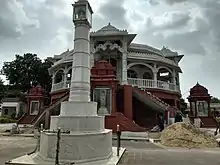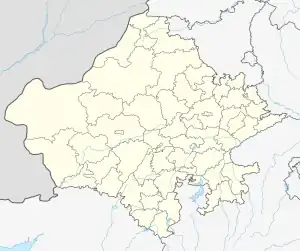Bijolia Parshvanath temple
Bijolia Parshvanath Temple or Tapodaya Teerth Kshetra is a Jain pilgrimage center located in Bijolia town in Bhilwara district of Rajasthan.
| Bijolia Parshvanath temple | |
|---|---|
 Shri Digambar Jain Parshwanath Atishay Kshetra | |
| Religion | |
| Affiliation | Jainism |
| Sect | Digambara |
| Deity | Parshvanatha |
| Festivals | Mahavir Jayanti |
| Governing body | Shri Digambar Jain Parshwanath Atishay Kshetra Committee |
| Location | |
| Location | Bijolia, Rajasthan |
 Location within Rajasthan | |
| Geographic coordinates | 25°08′59.3″N 75°20′15″E |
| Architecture | |
| Creator | Mahajan Lala |
| Date established | 12th century |
| Temple(s) | 11 |
History

Bijolia is famous for two rock inscriptions, both dated 1170 CE (V. S. 1226).[1] One inscription provides the genealogy of the Chahamanas of Shakambhari and the second is a Jaina poem called Uttama Sikhara Purana. The first inscription opens with salutation to Parshvanatha and records coronation of Somesvara. The third verse of inscription describes how Someshvara gave the grant to build Parshvanatha temple in Rewna village.[2][3][4] The latter inscription, engraved near the door of the Parsvanatha temple, records the homage of Manoratha, son of Mahidhara.[5] According to Jain tradition, this place is believed to be where the Uttama Sikhara Purana was composed.[6][7][8][9]
According to Peter Flügel, the Undeshvar Shiva temple of Bijolia was originally a Śvētāmbara temple based on carvings of prominent Jain figures in the temple exterior.[10]
About temple
Five Jain temples was constructed in 1160 CE by Mahajan Lala during the reign of King Somesvara of Chahamanas empire. The main temple is a large structure consisting of a small model of the temple.[11] The temple is dedicated to Parshvanatha and is a major Jain pilgrimage center.[1][12]
Gallery
 Pond near temple
Pond near temple Samavasarana mural
Samavasarana mural
 Footprints near temple
Footprints near temple
See also
References
Citations
- Carlleyle 1878, p. 239.
- Mishra 1973, p. 127.
- Kapoor 2002, p. 156.
- Bakshi 2005, p. 341.
- Aufrecht 1896, p. 27.
- Royal Asiatic Society of Great Britain and Ireland 1906, p. 700.
- Joshi & Deva 2006, p. 65.
- Sircar 2017, p. 71.
- ASI.
- Flügel 2006, p. 402.
- Archaeological Survey of India 1904, p. 8.
- Kanakk 2020.
Books
- Aufrecht, Theodor (1896). Catalogus Catalogorum: An Alphabetical Register of Sanskrit Works and Authors. Deutsche Morgenländische Gesellschaft. Vol. 2. F. A. Brockhaus AG.
- Archaeological Survey of India (1904). Supplementary List of Objects of Antiquarian Interest in the States of Rajputana (Mewar and Partabgarh) (PDF). Archaeological Survey of India.
- Bakshi, S. R. (2005). Early Aryans to Swaraj (1st ed.). Sarup Book Publishers Pvt. Limited. ISBN 978-81-7625-537-0.
- Carlleyle, A. C. L. (1878). Report of a Tour in Eastern Rajputana in 1871-72 and 1872-73. Vol. 6. Office of the Superintendent of Government Printing.
- Flügel, Peter (2006). Studies in Jaina History and Culture: Disputes and Dialogues. Routledge. ISBN 978-0-415-36099-9.
- Joshi, Jagat Pati; Deva, Krishna (2006). Inventory Of Monuments And Sites Of National Importance (PDF). Vol. 2 (1st ed.). Delhi: Archaeological Survey of India.
- Kapoor, Subodh (2002). Encyclopaedia of Ancient Indian Geography. Vol. 1 (Second ed.). New Delhi: Cosmo Publication. ISBN 978-81-7755-298-0.
- Mishra, Vibhuti Bhusana (1973). Religious Beliefs and Practices of North India During the Early Mediaeval Period. Asian Studies. Vol. 1. Brill Publishers. ISBN 978-90-04-03610-9.
- Royal Asiatic Society of Great Britain and Ireland (1906). Journal of the Royal Asiatic Society of Great Britain & Ireland. Cambridge University Press.
- Sircar, D. C. (2017) [1965]. Indian Epigraphy. Motilal Banarsidass. ISBN 978-81-208-4103-1.
Web
- Kanakk, Atul (11 October 2020). "Bijolia's resonance". The Hindu. Retrieved 13 October 2020.
- ASI. "Bijolia Inscription Parsvnath Temple". Archaeological Survey of India. Retrieved 4 May 2022.
External links
![]() Media related to Bijolia Parasnath at Wikimedia Commons
Media related to Bijolia Parasnath at Wikimedia Commons